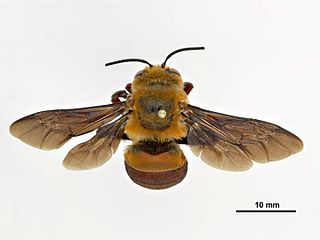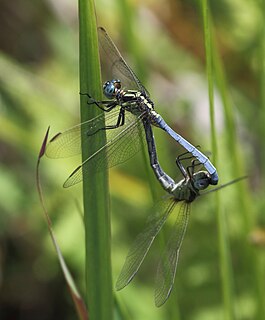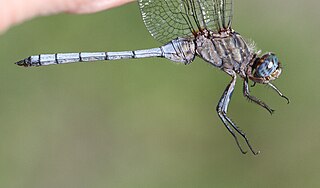 W
WAmegilla dawsoni, sometimes called the Dawson's burrowing bee is a species of bee that nests by the thousands in arid claypans in Western Australia. It is a long tongued bee, of the tribe Anthophorini and genus Amegilla, the second largest genus in Anthophorini.
 W
WAntipodogomphus is a genus of dragonflies in the family Gomphidae, endemic to Australia. The species are small to medium-sized with black with yellow markings. They are commonly known as dragons.
 W
WDiogmites neoternatus is a species of robber fly in the family Asilidae. Its genus name, Diogmites, refers to the peculiar habit of hanging by its foreleg while consuming prey.
 W
WDryocosmus kuriphilus is a species of gall wasp known by the common names chestnut gall wasp, Oriental chestnut gall wasp, and Asian chestnut gall wasp. It is native to China and it is known in many other parts of the world, particularly the Northern Hemisphere, as an introduced species and an invasive horticultural pest. It attacks many species of chestnut, including most cultivated varieties. It is considered the world's worst pest of chestnuts.
 W
WElimaea fallax is a species of katydid or bush cricket found in eastern Asia. It was originally described in 1951.
 W
WGynacantha dobsoni is a species of dragonfly in the family Aeshnidae, known as the lesser duskhawker. It inhabits ponds and swamps and is found in northern Australia.
 W
WHolcocephala fusca, the gnat ogre, is a species of robber flies in the family Asilidae.
 W
WHylaeus ornatus, the ornate masked bee, is a species of hymenopteran in the family Colletidae. It is found in North America.
 W
WMyrmecia arnoldi is a bull ant of the genus Myrmecia. Like all bull ants except for one species in this genus, the Myrmecia arnoldi is native to Australia.
 W
WMyrmecia comata is an Australian ant in the genus Myrmecia. This species is native to Australia and distributed mostly around Queensland. It was described as a species by John S. Clark in 1951.
 W
WMyrmecia fuscipes is an Australian ant which belongs to the genus Myrmecia. This species is native to Australia. Their distribution is heavily observed in South Australia and Western Australia.
 W
WMyrmecia gratiosa is an Australian ant which belongs to the genus Myrmecia. Native to Australia, this species is mainly found in Western Australia. During a study in Perth, it was realised that Myrmecia gratiosa was located in all locations where reactions in patients occurred. This concludes the species was responsible for ant sting anaphylaxis around Perth.
 W
WOrthetrum hintzi, the dark-shouldered skimmer is a species of dragonfly in the family Libellulidae. It is found in Angola, Benin, Botswana, Central African Republic, the Republic of the Congo, the Democratic Republic of the Congo, Ivory Coast, Equatorial Guinea, Ethiopia, Ghana, Guinea, Guinea-Bissau, Kenya, Liberia, Malawi, Mali, Mozambique, Namibia, Nigeria, Senegal, Sierra Leone, South Africa, Tanzania, Uganda, Zambia, Zimbabwe, and possibly Burundi. Its natural habitats are subtropical or tropical moist lowland forests, subtropical or tropical dry shrubland, subtropical or tropical moist shrubland, rivers, swamps, freshwater marshes, intermittent freshwater marshes, and freshwater springs.
 W
WOrthetrum migratum is an Australian freshwater dragonfly species in the family Libellulidae. The common name for this species is rosy skimmer. It inhabits streams, boggy seepages, riverine pools and swamps across northern Australia.
 W
WOrthetrum monardi is a species of dragonfly in the family Libellulidae. It is found in Angola, Benin, Burkina Faso, Cameroon, Central African Republic, the Republic of the Congo, Ivory Coast, Ethiopia, Gambia, Ghana, Guinea, Guinea-Bissau, Kenya, Nigeria, Sierra Leone, Tanzania, Uganda, and Zambia. Its natural habitat is subtropical or tropical swamps.
 W
WSolenopsis tennesseensis is a species of ant in the family Formicidae.
 W
WTrachymyrmex nogalensis is a species of higher myrmicine in the family Formicidae.